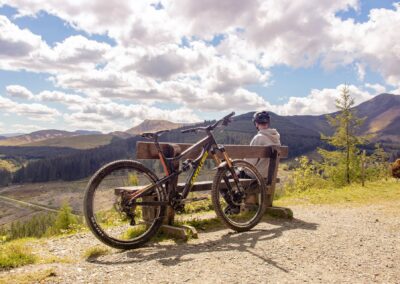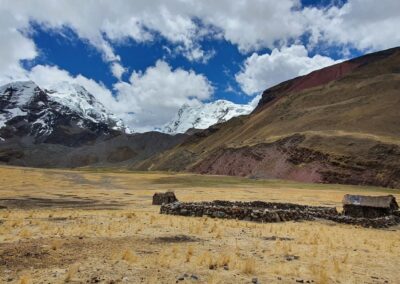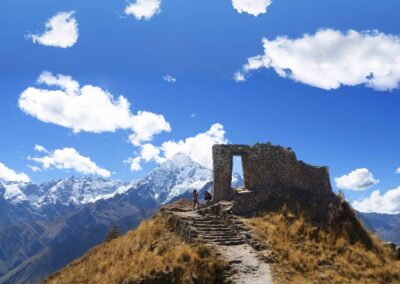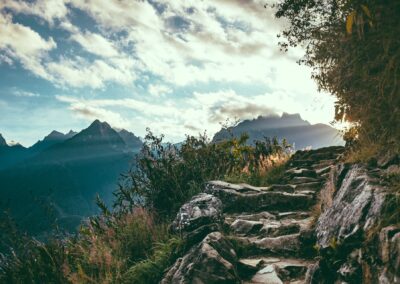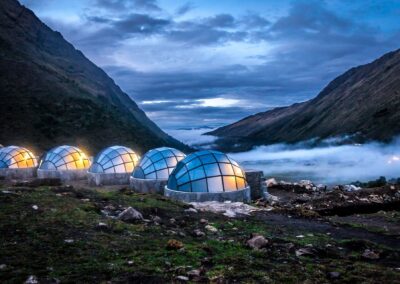Inca Jungle Bike Tour
4 Days / 3 Nights
ACTIVITIES
Biking, Hike, Camping
DURATION
4 Days / 3 Nights
MAX. ALTITUDE
4,200 mts
LOCATION
Machu Picchu, Cusco
Introduction
There are lovers of nature and also of adventure, thinking of them is that the experience of the Inca Jungle 4 days and 3 nights is realized. It is a spectacular activity that will fill us with adrenaline and emotion from the first day, showing us the most beautiful nature and culture of each place that we will see until finally reaching the world wonder of Machu Picchu.
This experience gives us endless emotions and stories to tell in our lives. The road is full of Flora and Fauna where we can discover that nature is our best refuge from the routine and stress that may exist on a daily basis.
This experience is intended for all people who have an adequate and optimal state of health in the face of the necessary requirement, you can do it individually to be able to meet new people, as a couple or with friends with whom to share emotions and also as a family to live a unforgettable adventure.
Get inspired for your next vacation with testimonials from traveling customers like you!
Why book this tour?
Feel the adrenaline with the bike descent from Abra Málaga.
Enjoy the spectacular hot springs of Cocalmayo.
Live an experiential experience with the local people of Santa Teresa and Santa Maria.
Taste the fantastic novoandina and local gastronomy.
Capture the best shots from the House of the Guardian.
Discover the mystery about the Intihuatana.
Fall in love with the Inca culture with its living history.
Summary Itinerary
Day 01: Cusco – Ollantaytambo – Abra Malaga – Santa Maria
- 07:15 – 11:30 Transfer and travel by tourist bus: Cusco – Abra Malaga.
- 11:50 – 13:15 Start of the guided bike adventure.
- 13:30 – 14:30 Lunch time on the route (box lunch).
- 14:30 – 16.00 Bike tour to Santa Maria.
- Optional Activity: Canoeing tour or free time to relax.
- Night at family home
Day 02: Santa Maria – Santa Teresa
- 06:00 – 10:40 Walking tour in Santa Maria.
- 11:00 – 12:00 Lunch at a restaurant in the town of Quellomayo.
- 12:15 – 13:30 Walk to the thermal baths of Santa Teresa.
- Optional Activity: relax in the thermal baths.
- 14:45 – 17:00 Walking tour to the town of Santa Teresa.
- Night at family home
Day 03: Santa Teresa – Town of Aguas Calientes
- 07:00 – 12:00 Guided walk from Santa Teresa to Hydroelectric.
- 12:00 – 13:15 Lunch time (Box Lunch).
- 13:30 – 16:00 Guided walk from Hydroelectric to Aguas Calientes.
- Hotel night in Aguas Calientes
Day 04: Aguas Calientes – Machu Picchu – Cusco
- 05:30 – 06:30 Hike up to Machu Picchu.
- 07:00 – 10:00 Guided tour in the Inca citadel of Machu Picchu.
- Free time to continue exploring the archaeological group, have lunch, visit the thermal baths or visit the craft market.
- 18:30 – 20:15 Return trip by train from Aguas Calientes to Ollantaytambo.
- 20:30 – 22:20 Transfer by bus from Ollantaytambo to Cusco.
Detailed Itinerary
During our adventure we will be able to pass through different places that hold a mystery and a beautiful view during the 4 days of walking until we finally reach Machu Picchu on the last day with all the energy to know this World Wonder, the places that we will be able to see are:
- Cocalmayo: It is located next to the Urubamba River and a small mountain. It is a perfect place for all visitors who make the journey from Salkantay to have a well-deserved rest in these pools fed by natural hot springs surrounded by varied vegetation. We found 3 pools of different sizes with a temperature between 38 and 44 ºC. We also find cold showers with water from the Uripata lagoon and it is very refreshing.
- Guardian House: This beautiful place is located in the highest area of the Inca citadel on the Agricultural Area. Its function was to control the entrance to the Inca city and review the entire agricultural and urban area. From here you can see a panoramic view of the entire citadel and the entrance to the old Inca trail. It has three walls: In the central wall we find three large windows, which allow us to easily observe the entrance to the Inca trail and the Inca bridge, the only means of communication with the outside world. We can also see how the Incas covered the enclosures with a ichu roof.
- Llacta Punku: It is the income for the urban sector, it is located limited by a deep excavation. This sector is located from the cemetery by a long staircase towards the peripheral neighborhoods, it has a system of points to hold a wooden door, in person and not as an element of restriction or security since the city can also be accessed by other roads.
- Ceremonial Plaza: It is a set of enclosures made around a quadrangular patio, you can see three polygonal walls, made with immense stone pieces assembled perfectly. The presence of three windows and two niches on each side stands out. It is considered that the function of these windows was probably purely religious, next to this we can find a different enclosure called The House of the Priest.
- Temple of the Sun (1:00 p.m. – 4:00 p.m.): This enclosure has a finely polished two-story structure: the first is semi-underground and the second features a beautiful semi-circular wall with perfect finishes, with an incline towards its interior due to what is called “Torreón”. It was used to celebrate religious ceremonies, especially during the months of June and December, special dates for the Solstices.
- This Tower has two trapezoidal windows, one oriented towards the most extreme point of the winter solstice that takes place on June 22 and the other oriented towards the Puerta del Sol (Intipunku) for the summer solstice that occurs on June 22. from December. In the middle of this architecture we can find a central rock, polished in the shape of an altar that was used for the ceremonies of interpretation of the path that the sun followed. It is built on a large rock, under which there is a small cave, which has been worked and covered with a thin wall, this is because it probably fulfilled the function of a mausoleum, because it has niches of a moderate size, where they placed the mallquis or mummies where they were worshipped.
- Temple of the 3 windows: This enclosure has three polygonal walls, built with enormous stone pieces perfectly assembled, highlighting 3 windows and 2 niches at each end. The function they had was religious magic and not only aesthetic.
- It was Hiram Bingham who carried out excavations in the front part of this temple, finding a large amount of fractured ceramics and highlighting the detail of the bases of this temple with a depth of more than three meters, here is also the possible symbolic figure of the head of a carved llama, this image is allegorical to the camelid because of the importance it had as a beast of burden, supplier of meat and clothing to the Incas.
- Main Temple: It has a finely polished structure with beautiful finishes, an enclosure framed by only three walls, each of the large pieces have been carefully crafted. The central wall has a dimension of 11 meters. Behind the Main Temple there is an enclosure whose function was probably also for religious use according to the records obtained and whose stones have no less than 32 angles, which makes its meaning quite mysterious.
- Intihuatana (07:00 a.m. – 10:00 a.m.): It bears his name in Quechua which translated means "where the sun hangs“, is an area that corresponds to one of the highest sectors of the Urban Zone. This is the most important area of Machu Picchu, at the top of this area we can find a huge sculpture made and carved with flat surfaces, a column of 66 cm. tall and with finely carved faces that complement the sculpture. The total space of the Intihuatana measures 8.60 meters and 1.76 meters high.
- The Intihuatana, is one of the most enigmatic objects of Machu Picchu, it is related to the sunrise and the mountains. The movement of the Sun causes projections of shadows at different times, this served to recognize and interpret them in different periods of the year.
- Sacred Rock: It is a carved stone that resembles the silhouette of a mountain. It is located next to the control point to access the Huayna Picchu Mountain, made up of two Huayrana-type environments (three-walled environment), with very high ceilings that face each other forming a small, almost square plaza. This rock has an important location, since it is on the path that leads to two very important sites such as Huayna Picchu and the Temple of the Moon.
- Water mirrors: Its name is in relation to the enclosure where they are found as well as to the constructions that are in the place. It is a wide sector, with a single access door, which is why it is attributed to be an Acllahuasi or House of Selected Women who were dedicated to spinning, cooking and preparing chicha or acja, for the privileged class.
-
Among the possible functions attributed to this space are:
- In one of its rooms, you can see two circular rock protrusions, which have the shape of mortars, they were probably used to grind grains or prepare dyes.
- It is also given the name of 2 water mirrors, because in the rainy season they agglomerate with water and allow us to see the reflected stars.
- Temple of the Condor (10:00 a.m. – 1:00 p.m.): It is a wide set of constructions, made taking advantage of the irregular shapes and on a cave that was notoriously used for ceremonies. The condor was an animal worshiped during Inca times and associated with the divinity of the mountains.
- The area is delimited by stairs and finely carved walls, its access is controlled by a double jamb door, which shows the hierarchy and the activities that took place in this area, it presents a great variety of closed and open environments with one and two levels.
- In the central patio it has as its main point, a carved rock, where the representation of the head and part of the body of a condor can be clearly distinguished. You can see the head, beak and eyes, as well as the necklace of white feathers of the Royal Condor, with the body projected towards the interior of the cave, which subtly joins two natural rocks.
- In this sector you can see the clear union of natural rocks with others worked by man, seeking to represent a tutelary deity. In the underground cave (the body of the Condor) offerings, ceramics and bone remains of camelids were found, which confirm the quality of a "ceremonial center" where offerings were made.
- In front of the temple of the condor enclosure we will find a 2-story structure that has two entrance doors, the second level is flush with the patio of the condor and by observation it must have served as the enclosure of the priest, in charge of the worship of the Condor. You descend to the first level by a staircase that connects to other rooms. In an environment attached to it, sectors for raising animals were found, other stairs lead to a lower platform.
- Water sources: We can see a large staircase next to which runs a system of 16 waterfalls, most of them carefully carved in polygonal blocks and surrounded by gutters made in the rock. The water comes from a spring in the heights of the Machu Picchu mountain that was channeled in Inca times. A separate channel at the top of the mountain also associates the seepage of rain from the mountain and diverts it to the main channel.l.
What's Included?
Included
-
Transfer upon arrival: It is done in private transport, from the airport to the hotel.
-
Detailed briefing: It takes place before the start of the service (The briefing is a complete orientation, explaining everything about the tour. In addition, any questions you may have about it will be clarified).
-
Small groups: We always handle an adequate amount of people, personalized shared tour style.
-
First level guide: Professional tour guide specialized in Cultural tourism (English/Spanish).
-
Feeding: 3 breakfasts, 3 lunches, 3 dinners during the trek. Includes lunch at a restaurant in Aguas Calientes on the fourth day, after the Machu Picchu tour.
-
Varied snack: Provided every day in a small cloth bag, so you can eat something during the walk. It consists of a fruit, an energy bar or a package of cookies and candies.
-
Lunch and dinner: They are buffet or semi-buffet, with a variety of Peruvian and fusion food. Desserts and non-alcoholic drinks are also served.
-
Varieties of diets: Vegetarian, vegan and other food are also available at the request of the tourist and at no additional cost. Please request your diet in advance, during the reservation.
-
Family House and 3* Hotel in Aguas Calientes: Every night we stay in basic hostels along the route that are family houses to live a more natural experience, only in the hotel in Aguas Calientes we will have a room that has a private bathroom, hot water, comfortable rooms, Wi-Fi, luggage storage and breakfast. the next day.
-
Uphill bus: From the town of Aguas Calientes to Machu Picchu for the guided tour.
-
Entrance tickets: Both for the Inca Trail and for the visit to the citadel of Machu Picchu.
-
Return bus: From the citadel of Machu Picchu to the town of Aguas Calientes, after the guided tour.
-
Train ride: From Aguas Calientes to the train station in Ollantaytambo. (Expedition Service).
- Sale of snacks on board: Alcoholic and non-alcoholic drinks, sweets.
- Sanitary facilities: At the station and inside the train.
- Souvenir sale: Baby alpaca collection.
-
Private transport: From the train station in Ollantaytambo to your hotel in the city of Cusco.
-
Final transfer: We take you from your hotel to the airport, on the day you indicate (prior coordination with us).
Not Included
- Airfare: Both international and national.
- Transportation: From Playa to the town of Santa Teresa.
- Breakfast of the first day. You will need to reserve it at your hotel early, before we come to pick you up.
- Sleeping bag: It is essential that you have one, that resists up to -18°C. They are stuffed with feathers (we rent them for US$25.00).
- Entrance to the Huayna Picchu mountain: This walk must be reserved separately, at an additional cost and well in advance.
- Personal expenses and Tips: How to buy handicrafts, clothes, drinks, etc. Tips are not included either, these are voluntary according to the service received.
- Travel insurance: It is a very important requirement for your safety and protection, for example in case of a medical emergency, the costs will be much lower.
What To Bring?
Trekking Articles
Backpack (30 or 50 liters), water bottle, trekking shoes, waterproof jacket.
Useful Elements
Passport, cash in soles (additional purchases)
Useful Items
Passport, Cash in soles, Camera, charging cord, Extra batteries.
Clothes
Small backpack, rain poncho (January and February – rainy season), warm clothes.
Health and Care
Sunscreen, sunglasses, insect repelent, sun hat, Small towel, Bottled water, Personal medication.

DIFFICULTY LEVEL
Desafiante

